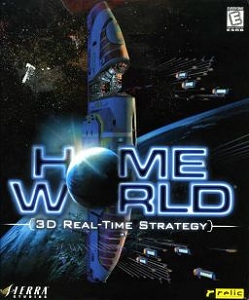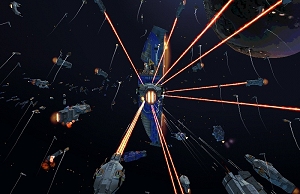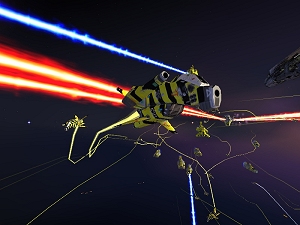 |
|
New England Gamer
|
August 2011
Returning to Homeworld
Homeworld was released in 1999 to widespread critical acclaim. At least I assume
it did. When I bought it in 2004, the only copy I could find was a bargain priced
version at Wal-Mart labeled "The Game of the Year Edition." It might sound
impressive, but it's a moniker that's hardly rare amongst video games. 2010 alone
had at least half a dozen self-proclaimed games of the year that I can recall, the
only pre-requisite being that at least one of the major gaming publications choose it
as their pick for the year.
I didn't buy Homeworld though on account of some dubious pedigree. It was a
game I'd wanted for years. I'd first read about in a now defunct PC gaming
magazine, but I'd never been able to play it on account of my not having a PC.
When my father, a veritable technophobe to this day, finally caved and bought a
computer toward the end of my stint in high school, the first thing I did was load it
down with old games that I'd always wanted to play.

Homeworld was one of these.
There have been a lot of games that have tried to emulate Homeworld, but to my
knowledge there haven't been any that have done what it did quite as well. At its
simplest, Homeworld was a strategy game and a basic one at that. Whereas most
strategy games pride themselves on unit variety and the complexity of their
mechanics, Homeworld was relatively simple. On one side you had the Taiidan and
on the other the Kushan. Each side had a unique visual aesthetic, but their units
were largely identical. Most battles could be won by the age-old strategy of simply
building a lot of units and overwhelming your opponent with sheer numbers.
That, admittedly, does the game a bit of disservice. Homeworld wasn't lacking in
its intricacies. The way it employed things like fighters, infinitely weaker than your
average capital ship but still a threat when used properly, was genuinely
interesting. It had its elements of skill, its own factors that the practiced player
could exploit to turn the tide their way. Even so, it wasn't exactly chess.
And yet it was unique in that it had a sense of drama. Not just in the story, which
took more than a few queues from Battlestar Galactica (the 70s version). The
combat itself had a sense of cinematic flair that was missing in other games. A
game like Starcraft might get your blood pumping, but it lacked that element of
awe that Homeworld possessed. Homeworld was that rare game where you could
enjoy it just as a spectator. On the one hand it was a gorgeous game for its time. On
the other it had one of the best cameras to ever grace a video game.

In a game like Starcraft, you watch the action from a top-down perspective. You
look down on your army like some sort of omnipotent, guiding your troops across
the landscape. Battles in turn, while still capable of some flash, still often look like
two sides pounding away at each other until one side wins. Homeworld was unique
in that it took its setting, outer space, and realized it in the only realistic way
possible: as a three-dimensional playing field.
While the necessities of gameplay still dictated a definite up and down, the player
could move their units and orient the camera however they wanted to. You could
zoom in or out as close or far as you wanted. You could play as the aloof
commander, or view the goings on from a closer range. And while these options
were definitely useful from a tactical standpoint, they also allowed for an
unparalleled sense of cinematic license.
You could watch the battle from afar, but you could also place yourself in the thick
of things. Watching the battle from the perspective of a titanic battle cruiser or
following it from the view of a tiny fighter amongst dozens. One of the greatest
joys I've ever known in a game was the simple process of snapping the camera to
one of my fighters and watching it simply trying to survive in the midst of the fray.
Watching it weave through the capital ships. Cringing as it was peppered by flak,
the staccato of its machine guns rattling my PC's speakers as it opened up on an
enemy target. It was like watching all the best scenes from Star Wars (X-Wings are
way cooler than lightsabers), but actually having agency over one side of the battle.
It was, simply put, a thrill.
Homeworld has been forgotten since then however. A part of this is just because
that's how video games work. A few minutes at a search engine could turn up
entire lists of wonderful games that have long since fallen into obscurity. That
being said, it didn't help that its sequels failed to live up to the original.
Homeworld: Cataclysm was a fun game with an interesting story, but it also ruined
a lot of what made the original special. It put a strict limit on how big of a fleet you
could build and even more egregious, it made fighters all but useless as the game
progressed. It tried to compensate by adding in an abundance of special abilities
and multipurpose units, but it still rang more hollow. As cool as some of the ships
in Cataclysm could be, watching a pair of dreadnaughts duke it out just wasn't as
much fun without fighters swarming about them in mortal combat

Homeworld 2 exacerbated things. It was a gorgeous game and still looks great
today, but it was also weighed down by some unfortunate additions to the
gameplay that made it less than the sum of its parts. Combat often feel automated.
All the player had to do was click a few buttons and watch as the AI did the rest of
the work for you. There are some who stand by it as a great game, but I never liked
it and find it telling that the series fizzled out immediately following.
Despite the franchise's decline, Homeworld itself is one of the few games where I
can say I watched it in wonder. Its best moments hold their own with memories
like the first time I played The Legend of Zelda: Ocarina of Time or the first time I
watched the sun rise in Red Dead Redemption. It's the sort of game that convinces
you that these don't have to be just mere toys, that they can touch something
deeper inside of you and stick with you years past their heyday in the same way as
a good movie, book, or song. As a boy I would often look up to the stars,
marveling at the possibility they represented. Homeworld took me to the stars and
showed me a shade of the possibility of what games could become.
Continued Below Advertisement
Read more by Stewart Shearer